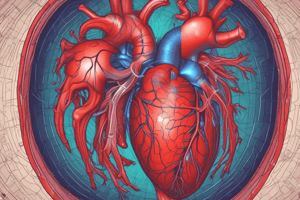Podcast
Questions and Answers
What is a potential consequence of a myocardium that is too high or too low?
What is a potential consequence of a myocardium that is too high or too low?
- Increased cardiac output
- Depressed myocardium (correct)
- Enhanced diastolic filling
- Elevated blood pressure
When a patient has a depressed myocardium, what type of medication might be considered?
When a patient has a depressed myocardium, what type of medication might be considered?
- Inotropes (correct)
- Diuretics
- Anticoagulants
- Beta-blockers
What nursing course is likely associated with the 'hemodynamics' topic and 'exam 1' mentioned?
What nursing course is likely associated with the 'hemodynamics' topic and 'exam 1' mentioned?
- NUR4050 (correct)
- NUR5050
- NUR3050
- NUR6050
What does the term 'diastolic filling volume' refer to?
What does the term 'diastolic filling volume' refer to?
According to the content, when will Exam 1 take place?
According to the content, when will Exam 1 take place?
If a patient has a depressed myocardium, would inotropes always be used?
If a patient has a depressed myocardium, would inotropes always be used?
What is the relationship between 'depressed myocardium' and 'diastolic filling volume'?
What is the relationship between 'depressed myocardium' and 'diastolic filling volume'?
What is the general subject matter being discussed in the context of 'week 3: hemodynamics'?
What is the general subject matter being discussed in the context of 'week 3: hemodynamics'?
According to the provided information, what is the optimal value range targeted?
According to the provided information, what is the optimal value range targeted?
If a student were studying 'NUR4050', which of these topics, in addition to hemodynamics, would they most likely be preparing for?
If a student were studying 'NUR4050', which of these topics, in addition to hemodynamics, would they most likely be preparing for?
What does a low value indicate?
What does a low value indicate?
What can be deduced about the timing of the 'hemodynamics' lecture relative to 'exam 1'?
What can be deduced about the timing of the 'hemodynamics' lecture relative to 'exam 1'?
If a patient's value is outside the specified range, what is the most immediate concern?
If a patient's value is outside the specified range, what is the most immediate concern?
Which of the following best describes the relationship between the described value and tissue perfusion?
Which of the following best describes the relationship between the described value and tissue perfusion?
If a patient presented with a value of 1, which clinical intervention would be a priority?
If a patient presented with a value of 1, which clinical intervention would be a priority?
Which of the following would not typically cause an increase in superior vena cava pressure?
Which of the following would not typically cause an increase in superior vena cava pressure?
A patient presents with signs of severe hypovolemia. What change in superior vena cava pressure would you expect?
A patient presents with signs of severe hypovolemia. What change in superior vena cava pressure would you expect?
Which of these factors will directly increase pulmonary vascular resistance?
Which of these factors will directly increase pulmonary vascular resistance?
A patient with a history of liver failure is showing signs of third-spacing. What effect does this have on superior vena cava pressure?
A patient with a history of liver failure is showing signs of third-spacing. What effect does this have on superior vena cava pressure?
Which of the following is NOT part of a basic hemodynamic physical assessment?
Which of the following is NOT part of a basic hemodynamic physical assessment?
What does CO refer to when discussing a pulmonary artery catheter?
What does CO refer to when discussing a pulmonary artery catheter?
Which of the following provides the most direct measurement of the balance between oxygen supply and demand in the body?
Which of the following provides the most direct measurement of the balance between oxygen supply and demand in the body?
What is the primary purpose of monitoring ScvO2 through a pulmonary artery catheter?
What is the primary purpose of monitoring ScvO2 through a pulmonary artery catheter?
If a patient's ScvO2 levels are lower than normal, what might this suggest?
If a patient's ScvO2 levels are lower than normal, what might this suggest?
Where is ScvO2 typically measured on a pulmonary artery catheter?
Where is ScvO2 typically measured on a pulmonary artery catheter?
What does an elevated ScvO2 reading typically suggest?
What does an elevated ScvO2 reading typically suggest?
Which of the following is a non-invasive method for monitoring cardiac output (CO) and related hemodynamic parameters?
Which of the following is a non-invasive method for monitoring cardiac output (CO) and related hemodynamic parameters?
A patient's ScvO2 is 55%. Based on this, which condition is most likely?
A patient's ScvO2 is 55%. Based on this, which condition is most likely?
If a patient's cardiac output is measured at 7 L/min, what might be the interpretation?
If a patient's cardiac output is measured at 7 L/min, what might be the interpretation?
What is the primary function of the EV1000 monitor in the context of hemodynamics?
What is the primary function of the EV1000 monitor in the context of hemodynamics?
Flashcards
Low Blood Pressure (4-6)
Low Blood Pressure (4-6)
A lower blood pressure reading, specifically between 4 and 6, may indicate a threat to tissue perfusion.
Tissue Perfusion
Tissue Perfusion
Tissue perfusion refers to the delivery of oxygen and nutrients to tissues and the removal of waste products.
Hemodynamics
Hemodynamics
The study of blood flow and its mechanics within the circulatory system.
Blood pressure
Blood pressure
Signup and view all the flashcards
Cardiac Output
Cardiac Output
Signup and view all the flashcards
Peripheral Vascular Resistance
Peripheral Vascular Resistance
Signup and view all the flashcards
Blood Flow
Blood Flow
Signup and view all the flashcards
Depressed Myocardium
Depressed Myocardium
Signup and view all the flashcards
Diastolic Filling Volume
Diastolic Filling Volume
Signup and view all the flashcards
Inotropes
Inotropes
Signup and view all the flashcards
Low Blood Flow to Myocardium
Low Blood Flow to Myocardium
Signup and view all the flashcards
High Blood Flow to Myocardium
High Blood Flow to Myocardium
Signup and view all the flashcards
Superior Vena Cava Pressure
Superior Vena Cava Pressure
Signup and view all the flashcards
Factors Increasing Superior Vena Cava Pressure
Factors Increasing Superior Vena Cava Pressure
Signup and view all the flashcards
Pulmonary Vascular Resistance and Superior Vena Cava Pressure
Pulmonary Vascular Resistance and Superior Vena Cava Pressure
Signup and view all the flashcards
Factors Decreasing Superior Vena Cava Pressure
Factors Decreasing Superior Vena Cava Pressure
Signup and view all the flashcards
Hemodynamic Status Assessment
Hemodynamic Status Assessment
Signup and view all the flashcards
What is a pulmonary artery catheter (PAC)?
What is a pulmonary artery catheter (PAC)?
Signup and view all the flashcards
What does ScvO2 monitoring involve?
What does ScvO2 monitoring involve?
Signup and view all the flashcards
Why is ScvO2 monitoring important?
Why is ScvO2 monitoring important?
Signup and view all the flashcards
What does high versus low ScvO2 mean?
What does high versus low ScvO2 mean?
Signup and view all the flashcards
How can ScvO2 monitoring be used?
How can ScvO2 monitoring be used?
Signup and view all the flashcards
ScvO2 (Central Venous Oxygen Saturation)
ScvO2 (Central Venous Oxygen Saturation)
Signup and view all the flashcards
Cardiac Output (CO)
Cardiac Output (CO)
Signup and view all the flashcards
Elevated ScvO2
Elevated ScvO2
Signup and view all the flashcards
Low ScvO2
Low ScvO2
Signup and view all the flashcards
EV1000 Monitor
EV1000 Monitor
Signup and view all the flashcards
Study Notes
Hemodynamics Week 3
- Labs for hemodynamic studies include: lactic acid, ABGs, ScvO2, troponin, BNP, and a comprehensive metabolic panel.
- Stress affects hemodynamics by increasing contractility, heart rate, blood pressure, and respiratory rate/gas exchange.
- Volume regulation cycle involves:
- Increased extracellular fluid volume leads to elevated ventricular/atrial pressure, causing ventricular/atrial wall expansion.
- Release of ANP and BNP, inhibiting the renin-angiotensin-aldosterone system (RAAS), resulting in decreased sodium and water excretion.
- Heart failure (CHF) differences: patients with CHF may not recognize BNP, which can lead to RAAS activation. Treatment often involves ACE inhibitors.
- Cardiac output is decreased due to reduced stroke volume.
- Afterload, the pressure required to open the aortic valve during systole (ventricular contraction), is a primary variable influencing stroke volume.
- Increased afterload: Hypertension, atherosclerosis, aortic stenosis, hypothermia, left ventricular failure, and stress. This can activate the RAAS system.
- Decreased afterload: hyperthermia, septic and anaphylactic shock, neurogenic shock, and vasodilation.
- Contractility is affected by:
- Increased by shock, positive inotropes and the sympathetic nervous system (SNS).
- Decreased by late sepsis, myocardial infarction (MI), negative inotropes, electrolyte imbalances, low oxygen levels, and acidosis.
- Diastolic filling volume (preload) is influenced by, circulating blood volume, heart failure, bleeding, vomiting, diarrhea, and diuresis and other variables.
- Frank-Starling curve predicts preload capacity, showing how cardiac output increases with volume until a maximum capacity, beyond which it starts declining due to increased ventricular load.
- Heart rate (HR) is affected by atrial systole and sympathetic stimulation, as well as possible bradycardia or atrial fibrillation (AFib).
- Decreased HR: loss of the atrial kick via bradycardia from symptomatic causes
- Increased Afterload: aorta stenosis, low ef, volume overload
- Desired HR: 4-6 bpm
- Increased right-sided pressure can be caused by left-sided overload, AV septal defects, or severe chronic lung disease (e.g., COPD, pulmonary hypertension).
- Central venous pressure (CVP) measures venous return and blood volume on the right side of the heart.
- CVP range: 0-10
- Factors increasing CVP include: intravascular volume and pulmonary vascular resistance.
- Factors decreasing CVP include: vasodilators and correction of hypoxemia, acidosis, exercise
- Monitoring hemodynamic status includes physical assessments and invasive measurements. Basic hemodynamic assessments involve pulse rate, blood pressure, heart sounds, mental status, and skin temperature. Invasive monitoring techniques include arterial lines, pulmonary artery catheters, and central venous catheters.
- Complications related to invasive monitoring: possible thrombus formation and infection, air embolism (related to fluid overload or deficits), and assessment of fluids.
- Invasive procedures need:
-Thick cath and high-pressure tubing.
-Transducer for electrical signal monitoring
-Monitoring device for assessing heart beats into electrical signals.
- Positioning to the 4th-5th intercostal space.
- Perfusion pressure changes due to altered cardiac rhythm/pressure bag, or transducer placement.
- PVC causes: ineffective ventricular contraction, longer filling period for the next beat resulting in increased systolic pressure for the next cardiac cycle
- Abnormal arterial waveforms or "over/under dampened rhythm" can be caused by excessive pressure in the catheter or kinking of the tubing
- Venous catheters are used for CVP monitoring.
- Sites for catheter insertion include the femoral, jugular, subclavian, brachial, or percutaneous-catheter (picc) veins.
- Central venous pressure (CVP) monitoring, ranges, cautions, and indications
- Pulmonary artery catheter (PAC) monitoring, indications
- Guidelines for fluid management post-op (e.g., cardiac surgery, CABG) and hemodynamic monitoring
- Cooling procedures for post-cardiac arrest patients and reasons
- Nursing interventions and complications related to post-cardiac arrest patients, including hemodynamic management
- Short-term mechanical circulatory support (e.g., intra-aortic balloon pump, ECMO) indications
Studying That Suits You
Use AI to generate personalized quizzes and flashcards to suit your learning preferences.




